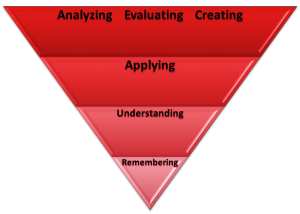Course Design
Design Fundamentals
Best practices for online course design are similar to those in the face-to-face classroom. Building upon the Principles of Online Learning, the goal for any course developer is to create opportunities that not only provide students with access to course materials but also foster interactions with both the content and other students in ways that stimulate higher-order thinking processes.
Basic Principles for Course Design
- Learning is an active process and takes place when students are engaged with the materials in a meaningful way.
- Students have learning style preference(s) – visual, auditory, kinesthetic – that impact how they process information. Online materials and activities should reflect a balance of different modalities to accommodate these styles.
- Students bring their own experiences and background knowledge (schema) to the course. Course activities should provide ways to activate students’ schema about a topic and use that information to scaffold (build) upon their knowledge.
- Students learn best when called upon to integrate course materials in a way that has real-world applications.
Bloom’s Taxonomy

Bloom’s Taxonomy is a classification of learning which is useful in understanding the different processes — cognitive, affective and psycho-motor — that students employ to learn. Even though all skill sets are important for online course development, the cognitive domain provides a useful rubric for the fundamentals of course design.
The diagram represents a revised model of Bloom’s Taxonomy where the point of the pyramid begins with the lower-order skill, remembering. Higher-order skills are not listed in a hierarchy but are rather seen as parallel cognitive processes.
In many traditional classrooms, for example, students are often called upon to simply memorize facts and data and recite them in some form such as objective (true-false, multiple-choice, fill-in) tests. Such ‘lower-order’ skills can have a place in the classroom but, if used in conjunction with ‘higher-order’ skills will provide greater opportunities for learning than if used in isolation. An example of this would be if a true-false ‘test’ is given at the beginning of a unit for students to assess their knowledge of a new topic and their results then used as a prompt for a goal-setting/reflection of what they would like to learn.
Using Bloom’s Taxonomy
Although course design involves a complex combination of pedagogical materials and activities, Bloom’s Taxonomy provides a straightforward way to frame language for classroom activities. It is important to keep in mind that even though the concepts are linear in the taxonomy, there is often overlap between skills. An activity or project that might be in the creating domain, for example, can also include skills such as analyzing, applying and remembering.
The following chart describes each skill in greater detail giving sample language that can be used can use to scaffold and construct activities for the classroom, as well as examples of student-centered activities that can be used in distance education.
| SKILL | DEFINITION | SAMPLE LANGUAGE PROMPTS | SAMPLE ACTIVITIES |
|---|---|---|---|
| REMEMBERING | Students recollect information they have received. | list, define, describe, identify, match, label |
|
| UNDERSTANDING | Students explain information and concepts. | explain, paraphrase, summarize, interpret, give an example of |
|
| APPLYING | Students utilize new information. | apply, construct, predict, solve, use |
|
| ANALYZING | Students break-down, examine and infer meaning from new information. | distinguish, compare/contrast, examine, break down, identify, infer |
|
| EVALUATING | Students assess their opinions of and reactions to content. | compare, evaluate, interpret, defend, support, explain, justify |
|
| CREATING | Students construct something new using fundamental principles from course materials. | combine, create, construct, devise, design, compose, explain, compile |
|
To learn more about best practices in course design, the @One Project offers a course, Introduction to Online Teaching and Learning. Contact the Distance Education Department to receive a scholarship code prior to course registration.
